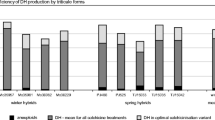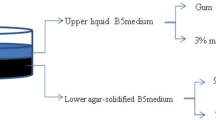Abstract
Five spring hexaploid wheat genotypes were evaluated for their androgenic ability, rate of spontaneous chromosome doubling and efficiency of different colchicine treatments on plantlets, and on embryoids obtained 45 days after anther culture. A concentration of 500 mg/1 of colchicine was used for 1 or 3 days for embryoid treatment. Results show significant genetic effects on androgenesis parameters; ‘Yecora Rojo’ and ‘Pavon’ being the best genotypes. Total, green and albino regeneration rates decreased when embryoids were colchicine treated. In most cases there were no significant differences between 1 or 3 days treatment, except for PI-49 and ‘Chenab’ genotypes which could not regenerate green plants with 3 days treatment. Chromosome doubling rates varied according to genotype. Spontaneous doubling ranged from 0% for PI-49 and ‘Chenab’ genotypes to 56% for ‘Yecora Rojo’. Chromosome doubling rate was at least 50% and raised to 100% in some cases when embryoids were colchicine treated, but because of a low regeneration frequency of these embryoids, treatment efficiency remained low. We propose that embryoid treatment with colchicine be recommended, for genotypes producing a high number of embryos or those which have a low rate of spontaneous chromosome doubling.
Similar content being viewed by others
References
Alemanno L, E. Guiderdoni, 1994. Increased doubled haploid plant regeneration from rice (Oryza sativa L.) anthers cultured on colchicine supplemented media. Plant Cell Rep. 13: 432–436.
Barnabas B, P.L. Pfahler, G. Kovacs, 1991. Direct effect of colchicine on the microspore embryogenesis to produce dihaploid plants in wheat (Triticum aestivum L). Theor. Appl. Genet. 81: 675–678.
Chu CC, R.D. Kilo, A.L. Brule-Babel, 1990. High frequency of pollen embryoid formation and plant regeneration in Triticum aestivum L. on monosaccharid containing media. Plant Sci. 66: 255–262.
Chuang CC, X. Jia, 1980. Annual report of the institute of genetics, Academia Sinica, Institute of Genetics, Academia Sinica p. 73.
Foroughi-Wehr B., F.J. Zeller, 1990. In vitro microspore reactionof different german wheat cultivars. Theor. Appl. Genet. 79: 77–80.
Ghaemi M, A. Sarrafi, G. Alibert, 1994. The effects of silver nitrate, colchicine, cupric sulfate and genotype on the production of embryoiids from anthers of tetraploid wheat (Triticum turgidum). Plant Cell Tiss. Org. Cult. 32: 41–46.
Hassawi D.S., G.H. Liang, 1991. Antimitotic agents: effects on double haploid production in wheat. Crop Sci. 31: 723–726.
Henry Y., J. De Buyser, 1981. Float culture of wheat anthers. Theor. Appl. Genet. 1:–79.
Hu H., 1985. Use of haploids in crop improvement. In Biotechnology in international agricultural research: Proceedings of the Inter Center Seminar on International Agricultural Research Centers (IARCS) and Biotechnology, 23–24 April 1984, Manila, Philippines. International Rice Reserach Institute, Manila, p. 74–84.
Mejza S.J., V. Morant, D.E. Dibona, J.R. Wong, 1993. Plant regeneration from isolated microspores of Triticum aestivum. Plant Cell Rep. 12: 149–153.
Metz S.G., H.C. Sharma, T.A. Armstrong, P.N. Mascia, 1988. Chromosome doubling and aneuploidy in anther derived plants from two winter wheat lines. Genome 1:–181.
Moeni A., A. Sarrafi, 1995. Genetic analysis for haploid regeneration responses on hexaploid wheat anther cultures. Plant Breeding 114: 247–249.
Möllers C., M.C.M. Iqbal, G. Röbbelen, 1994. Efficient production of doubled haploid Brassica napus plants by colchicine treatment of microspores. Euphytica 75: 95–104.
Navarro-Alvarez W., P.S. Baenziger, K.M. Eskridge, M. Hugo, V.D. Gustafson, 1994. Addition of colchicine to wheat anther culture media to increase doubled haploid plant production. Plant Breeding 112: 192–198.
Ouyang J.W., H. Liang, S.E. Jia, C. Zhang, T.H. Zhao, L.Z. He, X. Jia, 1994. Studies on the chromosome doubling of wheat pollen plants. Plant Sci. 98: 209–214.
Szakacs E., G. Kovacs, J. Pauk, 1988. Substitution analysis of callus induction and plant regeneration from anther culture in wheat (Triticum aestivum L.). Plant Cell Rep. 7: 127–129.
Takashima S., H. Hasegawa, A. Nakumura, 1995. A simple method for chromosome doubling in tobacco anther culture. Direct application of colchicine to anthers before culture. Breeding Science 45: 107–110.
Tanner D.G., 1981. Parental effects on chromosome doubling for the production of primary triticale. Can. J. Genet. Cytol. 23: 191–194.
Author information
Authors and Affiliations
Rights and permissions
About this article
Cite this article
Mentewab, A., Sarrafi, A. Androgenic ability and chromosome doubling by different colchicine treatments in anther culture of hexaploid wheat genotypes (Triticum aestivum L.). CEREAL RESEARCH COMMUNICATIONS 25, 897–903 (1997). https://doi.org/10.1007/BF03543894
Received:
Accepted:
Published:
Issue Date:
DOI: https://doi.org/10.1007/BF03543894




